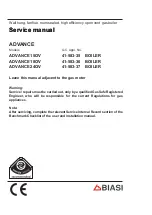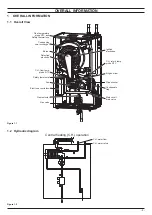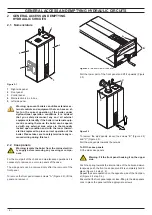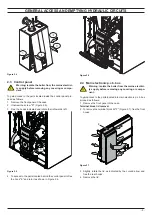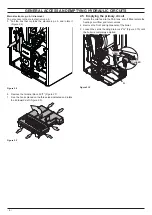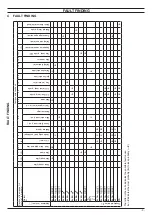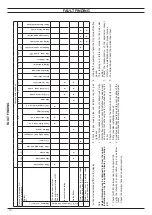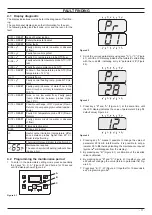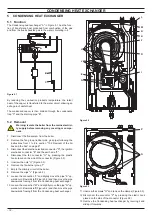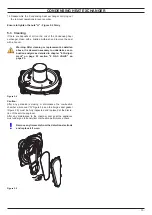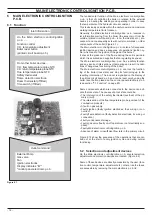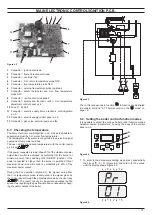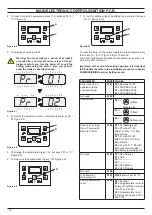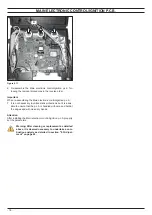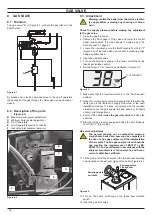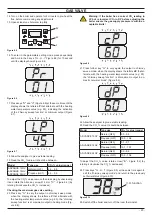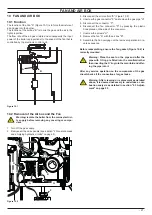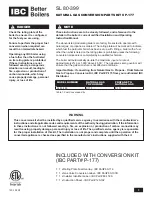
- 14 -
MAIN ELECTRONIC CONTROL/IGNITION P.C.B.
6 MAIN ELECTRONIC CONTROL/IGNITION
P .C .B .
6 .1 Function
Figure 6 .1
From other boiler devices....
C.H. flow temperature probe NTC
C.H. return temperature probe NTC
Flue temperature probe NTC
Safety thermostat
Flame detection electrode
Room thermostat (if fitted)
Time switch (if fitted)
On the
Main electronic control/ignition
p.c.b.
......
Function control
C.H. temperature adjustment
Boiler reset button
(printed circuit board p.c.b.)
Inlet Information
External Pump
Gas valve
Fan
Ignition electrodes
Display indicates “Er”*
*control panel electronic p.c.b.
Outlet command
The fundamental function of the
Main electronic control/ignition
p.c.b.
is that of controlling the boiler in relation to the external
needs (i.e. heating the dwelling) and operating in order to keep
the temperature of the hydraulic circuits constant.
This is obviously possible within the useful power and maximum
working temperature limits foreseen.
Generally, the
Main electronic control/ignition p.c.b.
receives in-
let information coming from the boiler (the sensors) or from the
outside (printed circuit board p.c.b., room thermostat, etc.), pro-
cesses it and consequently acts with outlet commands on other
components of the boiler (Figure 6.1).
The
Main electronic control/ignition p.c.b.
is also a full sequence
ignition device and does a sequence of operations (ignition cy-
cle) which lead to the ignition of the gas at the burner.
It checks the presence of the flame during the entire period in
which it is activated and supplies the fan regulating its speed.
The
Main electronic control/ignition p.c.b.
has a safety function
and any incorrect interventions or tampering can result in condi-
tions of dangerous functioning of the boiler.
The
Main electronic control/ignition p.c.b.
can lock the function-
ing of the boiler (lock state) and stop its functioning up to the
resetting intervention. The lock-out is signalled on the display of
the printed circuit board p.c.b. and can be reset only by using the
boiler reset button placed on the control panel electronic p.c.b.
(see section "7.1 Function" on page 20).
Some components which are connected to the device can acti-
vate the lock state. The causes of a lock state could be:
• The intervention of the safety thermostat (overheat of the pri-
mary circuit).
•
The intervention of the flue temperature probe (overheat of the
combustion products).
• A fault on gas supply.
• Faulty ignition (faulty ignition electrodes, their wiring or con-
nection).
•
Faulty flame detection (faulty detection electrode, its wiring or
connection).
• Faulty condensate drainage.
• Faulty gas valve (faulty on-off operators or not electrically sup-
plied).
• Faulty
Main electronic control/ignition p.c.b
..
•
Absence of water or insufficient flow rate in the primary circuit.
Figure 6.12 show the sequence of the operations that are car-
ried out at the start of every ignition cycle and during normal
functioning.
6 .2 Selection and adjustment devices
On the
Main electronic control/ignition p.c.b
. several selection,
adjustment and protection devices are located. (Figure 6.2).
Some of these devices are directly accessible by the user (func-
tion control, temperature adjustment etc.) others, like the fuses,
are accessible by removing the main electronic p.c.b. lid.

